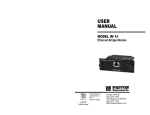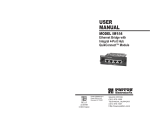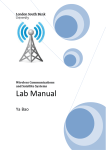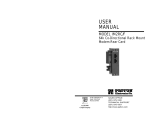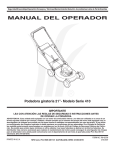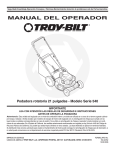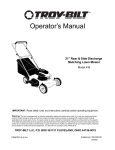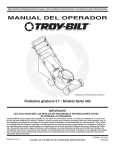Download Patton electronic IM1/I User's Manual
Transcript
USER M A N UA L MODEL IM 1/I Ethernet Bridge Module Part# 07MIM1I-D Doc# 090101UD Revised 7/29/99 An ISO-9001 Certified Company SALES OFFICE (301) 975-1000 TECHNICAL SUPPORT (301) 975-1007 http://www.patton.com 1.0 WARRANTY INFORMATION Patton Electronics warrants all Model IM1/I components to be free from defects, and will—at our option—repair or replace the product should it fail within one year from the first date of shipment. This warranty is limited to defects in workmanship or materials, and does not cover customer damage, abuse or unauthorized modification. If this product fails or does not perform as warranted, your sole recourse shall be repair or replacement as described above. Under no condition shall Patton Electronics be liable for any damages incurred by the use of this product. These damages include, but are not limited to, the following: lost profits, lost savings and incidental or consequential damages arising from the use of or inability to use this product. Patton Electronics specifically disclaims all other warranties, expressed or implied, and the installation or use of this product shall be deemed an acceptance of these terms by the user. 1.3 SERVICE All warranty and nonwarranty repairs must be returned freight prepaid and insured to Patton Electronics. All returns must have a Return Materials Authorization number on the outside of the shipping container. This number may be obtained from Patton Electronics Technical Service at: (301) 975-1007, http://www.patton.com; [email protected]. NOTE: Packages received without an RMA number will not be accepted. Patton Electronics’ technical staff is also available to answer any questions that might arise concerning the installation or use of your Model IM 1/I. Technical Service hours: 8AM to 5PM EST, Monday through Friday. 1.1 RADIO AND TV INTERFERENCE WARNING! The Model IM1/I generates and uses radio frequency energy, and if not installed and used properly—that is, in strict accordance with the manufacturer’s instructions—may cause interference to radio and television reception. The Model IM1/I has been tested and complies with the limits for a Class A computing device in accordance with the specification in Subpart J of Part 15 of FCC rules, that are designed to provide reasonable protection from such interference in a commercial installation. However, this is no guarantee that interference will not occur in a particular installation. If the Model IM1/I does cause interference to radio or television reception, which can be determined by disconnecting the unit, the user is encouraged to try to correct the interference by one or more of the following measures: moving the computing equipment away from the receiver, reorienting the receiving antenna and/or plugging the receiving equipment into a different AC outlet (such that the computing equipment and receiver are on different branches). In the event the user detects intermittent or continuous product malfunction due to nearby high power transmitting radio frequency equipment, the user is strongly advised to use only a shielded twisted pair data cable that is bonded to metalized external outer shield plugs at both ends. The use of a shielded cable satisfies compliance with the Electromagnetic Compatibility (EMC) directive. This device is not intended to be connected to the public telephone network. 1.2 CE NOTICE The CE symbol on your Patton Electronics equipment indicates that it is in compliance with the Electromagnetic Compatibility (EMC) directive and the Low Voltage Directive (LVD) of the Union European (EU). A Certificate of Compliance is available by contacting Patton Technical Support. 1 2 2.0 GENERAL INFORMATION 2.3 TYPICAL APPLICATION Thank you for your purchase of this Patton Electronics product. This product has been thoroughly inspected and tested and is warranted for One Year parts and labor. If any questions or problems arise during installation or use of this product, please do not hesitate to contact us at: (301) 975-1007, http://www.patton.com; [email protected]. The Model IM1/I QuickConnect™ is designed to plug directly into the rear of a Patton Electronics baseband modem (i.e. Model 1090 or 1092). The Model IM1/I is designed to be used as one of a pair of units. Figure 1 (below) illustrates a typical Model IM1/I installation. 2.1 FEATURES Corporate Headquarters Ethernet WAN Bridge QuikConnect™ Module • Installs in Patton’s baseband modem, CSU/DSU, 64k/G.703 converter and fiber modem base units • Provides MAC level connection between two peered Ethernet LANs DDS Network PCM Network 768k Leased Line 512k Leased Line 128k Leased Line 64k Leased Line 128k Single Fiber 256k Single Fiber LAN • Operates transparently to higher level protocols such as TCP/IP, DECnet, NETBIOS and IPX Ethernet WAN Bridge QuikConnect™ Module • No configuration necessary (Model 2530) (Model 2073) (Model 1094) (Model 1093) (Model 1092) (Model 1090) (Model 1184) (Model 1185) Remote/Satellite Office • Automatically discovers, loads and deletes MAC addresses LAN • 512 KB on-board RAM • Modular 10Base-T connection (RJ-45) • Two LED indicators: status & link integrity Figure 1. Typical Model IM1/I application 2.2 DESCRIPTION The Patton IM1/I QuikConnect™ Ethernet WAN bridge module installs in Patton’s copper and fiber base units to provide seamless Ethernet LAN extension. The Patton IM1/I performs the bridging function between two physically separate Ethernet LANs at the MAC level. Operation of the Patton IM1/I is transparent to higher network level protocols such as TCP/IP, DECnet, NETBIOS and IPX. Once installed in the local Patton base unit, the Patton IM1/I works in a “plug and play” manner to forward LAN broadcasts, multicasts and frames destined for the peered Ethernet LAN at the remote end (the Patton base unit at the remote end must also be equipped with an IM1/I module). Using the Patton IM1/I, peered Ethernet LANs can be linked over leased 2-wire/4-wire, DDS, PCM and campus fiber circuits. 3 4 3.0 CONFIGURATION 4.0 INSTALLATION The Model IM1/I module plugs into Patton’s fiber and copper baseband modems to provide Ethernet LAN extension. The IM1/I has no switches or jumpers and does not need to be configured. However, factors such as ty type of medium, throughput across the link and clocking mode must be determined by the settings of the baseband modems. Please refer to your baseband modem (i.e. 1092A, 1093, 1095, 1185, etc) to make the following settings. The Model IM1/I is completely plug and play. This section tells you how to make the connections. 1) 2) 4.1 INSTALLING THE QUICKCONNECT™ MODULE Bit Rate: The DTE rate setting of your base unit corresponds to the throughput of your IM1/I bridge module. Use higher speeds to allow maximum throughput to your extended LAN. Each Quick Connect Module™ has a 50-pin card edge connector on one side and an ethernet interface on the other. The instructions below describe how to remove the existing QuickConnect™ Module and how to install the new IM1/I module. If your base unit does not have an existing QuickConnect™ already installed, please skip to section 3.2.2. NOTE: The IM1/I only supports synchronous speeds. 4.1.1 Removing the Existing QuickConnect™ Module Clocking Mode: Set the clocking modes on the base units so that one unit is configured for Internal clocking mode and the other unit is set for Receive Recover clocking mode. BASE UNIT CLOCK MODES Unit “A” Unit “B” Internal Clock Setting Receive Recover Clock Setting 1) Turn the power switch off. Leave the power cord plugged into a grounded outlet to keep the unit grounded. 2) Loosen the two thumbscrews on the module by turning them counterclockwise. 3) Grasp the two thumbscrews and gently pull the module from the unit. Apply equal force to the thumbscrews to keep the module straight during the removal process NOTE: Unit “A” and Unit “B” are arbitrarily chosen. It does not matter which unit is “A”, and which is “B”. 3) All other base unit settings depend upon your application and on the application medium (twisted pair or coaxial cable) 5 6 3.1.2 Installing the New QuickConnect™ Module 4.2 CONNECTING TO THE 10BASE-T ETHERNET PORT 1) Make sure the power switch on the base unit is off. Leave the power cord plugged into a grounded outlet to keep the unit grounded. The RJ-45 Ethernet port on Model IM1/I is designed to connect directly to a 10BaseT network. Figure 3, below, shows the 10BaseT RJ-45 port pin description. You may make connections up to 330 feet using Type 4 or 5 cable. 2) Hold the module with the faceplate toward you and align the module with the guide slots in the rear panel of the base unit. 3) While keeping the module’s faceplate parallel with the base unit rear panel, slide the module straight in–so that the card edge contacts line up with the socket inside the chassis. Figure 2 (below) shows how a Quick Connect Module plugs into the rear of the base unit. 1 2 3 4 5 6 7 8 1 TD+ (data output from IM1/I) 2 TD- (data output from IM1/I) 3 RD+ (data input to IM1/I) 4 (no connection) 5 (no connection) 6 RD- (data input to IM1/I) 7 (no connection) 8 (no connection) Figure 3. Model IM1/I RJ-45 Connector Pinout 4.2.1 Connecting the 10Base-T Ethernet Port to a Hub e Lin rt Po ce rfa Inte N 1O The Model IM1/I 10Base-T interface is configured as DTE (Data Terminal Equipment), just like a 10Base-T network interface card in a PC. Therefore, it “expects” to connect to a 10Base-T Hub using a straight-through RJ-45 cable. Use the diagram below to construct a cable to connect the IM1/I to a 10Base-T Hub. FF 0O Figure 2. Installation of Model IM 1/I Plug-in Serial Interface Module NOTE: The card edge connector should meet the socket when it is almost all the way into the chassis. If you encounter a lot of resistance, remove the module and repeat steps 2 & 3. 4) With the card edge contacts aligned with the socket, firmly seat the module by using your thumbs to apply pressure directly to the right and left edges of the module faceplate. Applying moderate and even pressure should be sufficient to seat the module. You should hear it “click” into place. 5) To secure the module in place, push the thumbscrews into the chassis and turn the screws clockwise to tighten. IM1/I RJ-45 Pin No. 1 (TX+) 2 (TX-) 10Base-T Hub RJ-45 Pin No. 1 (RX+) 2 (RX-) 3 (RX+) 6 (RX-) 3 (TX+) 6 (TX-) 4.2.2 Connecting the 10Base-T Ethernet Port to a PC (DTE) The Model IM1/I 10Base-T interface is configured as DTE (Data Terminal Equipment). If you wish to connect the IM1/I to another DTE device such as a 10Base-T network interface card in a PC, you must construct a 10Base-T crossover cable as shown in the diagram below. IM1/I 10Base-T DTE RJ-45 Pin No. RJ-45 Pin No. 1 (TX+) 1 (TX+) 2 (TX-) 2 (TX-) 3 (RX+) 6 (RX-) 3 (RX+) 6 (RX-) 8 7 5.0 OPERAT I O N 4.3 CONNECTION TO THE LINE INTERFACE MEDIA Instructions for connecting the line interface media (twisted pair , or fiber optic cable) are contained within the base unit user manual. Please refer to the base unit manual for connection details. Once the Model IM1/1 is installed, it should operate transparently. This sections describes power-up, general operating instructions, and the LED status monitors. 5.1 OPERATING INSTRUCTIONS Notice! Any terminal cable connected to the Model IM1/I must be shielded cable, and the outer shield must be 360 degree bonded–at both ends–to a metal or metalized backshell. 4.4 CONNECTING TO AC OR DC POWER Instructions for connecting the power supply Universal Interface AC Power Supply and DC Power Supply option) are contained within the base unit user manual. Please refer to the base unit manual for connection details. WARNING! The Model IM1/I interface card has been specifically designed to work with UI and DC versions of Patton Electronics base units. Use with 120/230VAC versions could result in damage to the unit. If you are unsure of your base unit power supply, please contact Patton Electronics technical support at (301)975-1000 or at [email protected]. 9 In order to operate, the Model IM1/I must be installed in the base unit. It also requires a 10Base-T connection. After power is applied, the IM1/I automatically starts performing the bridging function without further user intervention. MAC addresses discovered are automatically loaded into the MAC address table. They are automatically deleted from the MAC address table if they experience an inactivity of 8 minutes. 5.2 POWER-UP Before applying power to the IM1/I, please be sure it is properly installed in the base unit. Then make sure that unit is connected to the appropriate power source (Universal Interface AC Power Supply or DC Power Supply). Then power-up the base unit using the rear power switch . 10 APPENDIX A 5.3 LED STATUS MONITORS The Model IM1/I features two LEDs that monitor general operating status and the 10Base-T twisted pair link integrity. Figure 4 (below) shows the LEDs located directly beneath the RJ-45 jack. Following Figure 4 is a description of each LEDs function. Quik-Connect Interface Module Link LED Status LED Interface Port PATTON MODEL IM1/I SPECIFICATIONS LAN Connection: RJ-45, 10Base-T, 802.3 Ethernet MAC Address Table Size: 4096 entries MAC Address Aging: MAC addresses deleted after 8 minutes inactivity On-board Memory: 512 KB RAM; 128 KB FLASH Frame Latency: 1 frame Interface: card-edge connection to QuikConnect™ port on Patton base unit LED Indicators: (1) general status; (1) link integrity Power Supply: +5 Volts @ 510 mA supplied to module by connection to Patton QuikConnect interface Temperature Range: 32 to 122ºF (0 to 50º C) Dimensions: 2.9" x 3.2" (7.4 cm x 8.1 cm) Weight: 0.25 lb (0.11 kg) Figure 4. Model IM1/I Panel Status Blinks yellow from one to eleven times to indicate system status. Each pulse pattern is separated by a 2 second “off” period. Greater pulse patterns have higher priority (buffer saturation has greater priority than an empty MAC table). Valid system statuses are: 1 pulse = system status is okay 2 pulses = no MAC entries in the MAC Address Table 3 pulses = Clear to Send (CTS) or Carrier Detect (DCD) from base unit are not asserted 4 pulses = IM1/I buffer is saturated 5 pulses = WAN receive frame(s) too large 6 pulses = WAN receive frame(s) not octet aligned 7 pulses = WAN receive frame(s) aborted 8 pulses = Detected WAN receive frame(s) with CRC 9 pulses = Detected LAN receive frame(s) too large 10 pulses = Detected LAN receive frame(s) not octet aligned 11 pulses = Detected LAN receive frame(s) with bad CRC Link Glows green to indicate good link integrity on the 10Base-T twisted pair line. 11 12 APPENDIX B IM1/I INTERFACE PIN ASSIGNMENT Dear Valued Customer, Thank you for purchasing Patton Electronics products! We do appreciate your business. I trust that you find this user manual helpful. 10BASE-T Interface Pin Description (RJ-45 Female Connector) (DTE Configuration) Pin # 1 2 3 4 5 6 7 8 Signal TD + (data output from IM1/I) TD - (data output from IM1/I) RD +(data input to IM1/I) no connection no connection RD - (data input to IM1/I) no connection no connection We manufacture one of the widest selections of data communications products in the world including CSU/DSU's, network termination units, powered and self-powered short range modems, fiber optic modems, interface converters, baluns, electronic data switches, data-line surge protectors, multiplexers, transceivers, hubs, print servers and much more. We produce these products at our Gaithersburg, MD, USA, facility, and can custom manufacture products for your unique needs. We would like to hear from you. Please contact us in any of the following ways to tell us how you like this product and how we can meet your product needs today and in the future. Web: Sales E-mail: Support E-mail: Phone - Sales Phone - Support Fax: Mail: http://www.patton.com [email protected] [email protected] (301) 975-1000 (301) 975-1007 (301) 869-9293 Patton Electronics Company 7622 Rickenbacker Drive Gaithersburg, MD 20879 USA We are committed to a quality product at a quality price. Patton Electronics is BABT and ISO 9001 certified. We meet and exceed the highest standards in the industry (CE, UL, etc.). It is our business to serve you. If you are not satisfied with any aspect of this product or the service provided from Patton Electronics or its distributors, please let me know. Thank you. Burton A.Patton Executive Vice President © Copyright 1998 Patton Electronics Company All Rights Reserved 13 P.S. Please tell us where you purchased this product. ________________________________________________________ ________________________________________________________ ________________________________________________________ ________________________________________________________ ________________________________________________________ ________________________________________________________ ________________________________________________________ _______








